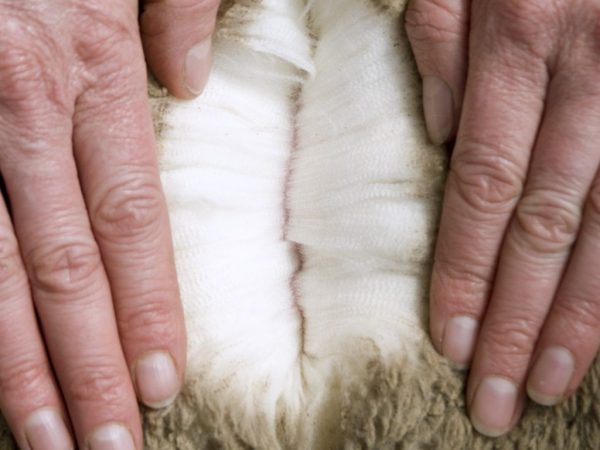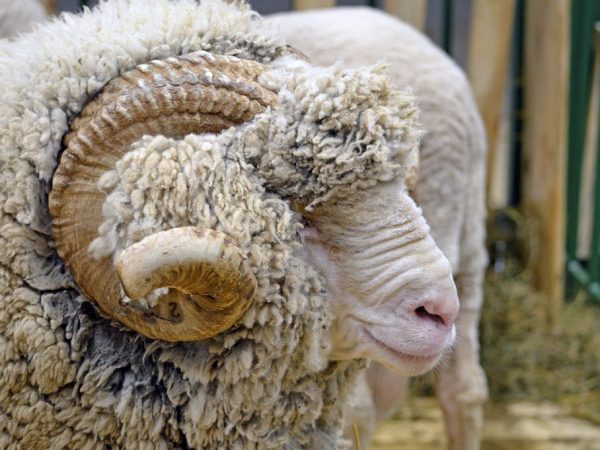Characteristics of the breed Merino
Merino is a representative of sheep, which enables the farmer to obtain expensive fluff and wool. Such a field of human activity as sheep breeding is expanding every day, so the presence of such a breed is a prerequisite for a farmer. Consider what a Merino sheep is, what makes such a breed unique, how to breed and keep it in the household.

Description of the breed Merino
Features of origin
In fact, the Merino is a breed that was bred in Spain in the Middle Ages, and therefore has a Spanish name. Such an animal was considered a fine-wooled representative, since, considering the features of the wool, one can notice that it is a soft and thin fiber. If we compare these animals with other representatives of sheep of meat breeds, then they give a lot of wool. But if we take other representatives of the variety in question, the weight of the resulting wool can be commensurate with the meat indicator.
A variety of Merino was obtained for the first time on the territory of Spain in the distant XIII century. To obtain a good breed, North African and Middle Eastern sheep were crossed among themselves. Until the 17th century, the inhabitants of Spain were considered real monopolists in this area, but already in the 18th century all exports were banned, and the death penalty was the punishment for taking action. Only after the defeat in the war in the 18th century, it turned out to take out several samples on the territory of other countries.
Already in new territories, representatives of sheep were used for breeding in their pure form or were considered as animals that could be crossed with another species to obtain a new representative of this category. Naturally, by crossing such sheep with others, it was possible to obtain productive animals. Today, representatives of the variety are very common: they can be found on all continents of the globe.
Wool value
An animal such as Merino is valuable among other representatives of sheep due to its unique wool, which is a high-quality and delicate product. If we compare a human hair with the wool of this animal, the second will be several times thinner, but also several times stronger. Due to this, the variety belongs to fine-wool.

Merino wool
This breed of sheep has the thinnest and most valuable woolen cover on the withers. Here it is warm enough, tender, soft and has a special snow-white appearance. If we consider how much such raw materials are valued and who has the most valuable wool, then Australian and New Zealand Merino merino beads fall into a similar list. In this case, the characteristics of the wool cover of a sheep of the Merino breed will be as follows:
- you can feel special warmth;
- soft and pleasant to the touch;
- excellent hygroscopic performance.
Despite the fact that the Merino wool cover is valued for its quality, do not forget that from such an animal you can get 4-5 times more ready-made fabric than from an animal of any other meat breed.Moreover, all clothes made from such raw materials will never smell of human sweat.
Distinctive features
The features of the Merino breed include:
- unpretentiousness of Merino in care, undemanding to the diet;
- fairly easy adaptability to a variety of climatic conditions and temperature regimes;
- high fertility rates, which cannot be said about other breeds;
- excellent heat transfer performance between the body and the environment.
Merino sheep are sheep that today make it possible to obtain a good quality fleece with excellent hygroscopic properties. At the same time, Merino rams have such a dense and dense fleece cover that it is quite difficult to see even a muzzle behind it.
The most common types
There are a decent number of varieties of the described breed. The variety of representatives of the Merino breeds is actually very large, but among them only those that are found most often can be distinguished and, accordingly, are bred at home. These types include the following:
- Soviet Merino;
- Altaic;
- Dzhalginsky Merino;
- Spanish.
And this is not the whole list.
Soviet-style merino was introduced to the territory of the former USSR for the purchase of wool, and then meat. Nowadays, these animals can be most often found in Siberia, Stavropol and Dagestan. Due to the detailed and high-quality work of the breeders, who did a great job, it was possible to obtain a fairly improved breed with excellent indicators of both wool and meat. At the same time, sheep weigh about 50 kg, and adult Merino rams weigh about 110 kg.

Soviet Merino
Despite the fact that Merino are considered fine-wooled animals, in one year about 15-20 kg of wool can be sheared from one ram, and about 7-8 kg from a lamb. At the same time, this species is especially valuable because there are about 120 cubs per 100 adult Merino. If we consider the Altai representatives, this variety took about 20 years of fruitful work of breeders. They are good primarily because they have a fairly strong body constitution.
Fertility is also high, as a hundred adults can give birth to 150-170 lambs.
Nowadays, a similar variety is found not only in Altai, but also in Bashkortostan and the Chelyabinsk region.
One of the latest achievements of breeders is the ram known as the Merinos of the Dzhalginsky species. If we consider such an animal and its detailed description, it is worth paying attention to the fact that, in comparison with other breeds, it has almost identical indicators of meat and wool productivity.
Also, don't forget the Spanish Merino, as they are also in high demand among today's farmers.
Having looked at numerous photos of Merino sheep, it is safe to say that this is an amazing variety of sheep. But everyone who at least once held things made of Merino wool in their hands can say with confidence that they are good not only because they are soft and comfortable, but also because of the ability to serve a person for a huge number of years.


